#foxconn
Explore tagged Tumblr posts
Video
youtube



Sharp LDK+ Concept, 2024. Japanese appliance marker Sharp have teamed up with tech giant Foxconn to created an electric minivan prototype that is a living room on wheels. Features include liquid crystal shutters on the side windows for privacy, rotating rear seating and a massive 65V display that can create an immersive theatre space, a children's play area or a remote work station.
#youtube#sharp#Sharp LDK+ Concept#Foxconn#concept#minivan#prototype#design study#video#concept van#MPV#electric vehicle#EV#electric van
121 notes
·
View notes
Text
Lisa Needham at Public Notice:
Trump surrogates have been fanning out to talk about how great it will be when factories return to the United States, which will happen magically and friction-free, all thanks to crushing tariffs. Perhaps the most preposterous example of this talking point (so far) was served up last weekend by Commerce Secretary Howard Lutnick, who went on Face the Nation and hyped that “the army of millions and millions of human beings screwing in little screws to make iPhones — that kind of thing is going to come to America.” But even if the Trumpian dream of returning assembly lines and the like to America was easily attainable — which it isn’t — those jobs would look nothing like the ones from the heyday of American manufacturing. Instead, thanks to the same administration currently banging on about their return, those jobs would be unsafe and unsustainable. First, the idea that companies can plop a factory any old place in America and just start cranking out cars or jeans or widgets or whatever is untethered from reality. Large-scale factory building takes years and costs a ton. It also takes infrastructure, like roads and access to shipping routes. To see what actually happens when Republicans are in charge of getting domestic manufacturing up and running, cast your eyes back to the Foxconn debacle. Wisconsin’s governor at the time, Scott Walker, promised Foxconn the moon to move to the Village of Mount Pleasant. In 2018, Trump showed up and used a stupid golden shovel to move a couple bits of dirt. But luring Foxconn with promised treats like $4 billion in tax breaks and water from Lake Michigan didn’t result in the promised 13,000 manufacturing jobs. Last time anyone checked, all that had been built was a weird 100-foot sphere that is available for event rental. The losers here were state and local governments, which spent half a billion dollars getting the Foxconn site ready.
There’s also the fact that Trump promised this golden age of manufacturing, mining, and good stateside jobs during his first term. In reality, he sat on his hands while companies offshored and the manufacturing sector shrunk. He was also going to bring back coal, which also didn’t turn out so great, with US coal production in 2019 coming in at its lowest level since 1978. (Trump held a big event at the White House yesterday touting once again to bring back coal, which shows that orange dogs can’t learn new tricks.) [...] Conservatives have made it a decades-long project to undo worker protections. Indeed, that project well predates the always-fetishized 1950s. They’ve been furious since what is known as the Lochner era ended back in 1937, and they’ve been trying to drag us back to a deregulated nightmare ever since. The second Trump administration might just be their chance to pull it off. For a stretch of about forty years, from 1897 to 1937, the United States Supreme Court made the world a veritable paradise not for workers, but for employers. You’ll note that Trump routinely invokes 1870 to 1913 — the Gilded Age — as a time of unmatched American prosperity. That was indeed true for rich people. The Rockefellers of the world got exceedingly wealthy, in no small part because politicians who were in thrall to them helped by doing things like crushing labor movements and allowing corruption to run rampant. Since conservatives love to dress up their brutality and corruption in high-minded ways, they frame the Lochner era as one where economic liberty was greatest, as was the “liberty to contract.” That sure sounds nice. Workers should definitely have the liberty to contract. Except in this instance, it actually meant “liberty for your employer to exploit you.”
The Lochner case involved a New York regulation that prevented bakery workers from working more than 60 hours per week or 10 hours per day. The idea was to provide some protection against grueling and largely unregulated working conditions. Lochner, the bakery owner, sued, saying that the regulation interfered with his liberty to contract with employees. In striking down the regulation, the Supreme Court explained they were really doing it for the workers: “The employee may desire to earn the extra money which would arise from his working more than the prescribed time, but this statute forbids the employer from permitting the employee to earn it. The statute necessarily interferes with the right of contract between the employer and employees.”
While that statement may indeed be true factually, it’s laughable legally. It’s based on the notion that employers and workers have the same bargaining power, and hey, if those workers want to work over 60 grueling hours in a bakery or in dangerous conditions, who are we to say no? But workers don’t have the same power as employers, and everyone knows it. What the Lochner holding really meant was that states couldn’t pass laws to protect workers, wrapped in the fiction that the workers themselves wanted that and would somehow flourish in unregulated industrial jobs. These are the same arguments conservatives still trot out today about the so-called “right to work.” Those laws are spun as pro-worker, freeing them from the tyranny of unions and allowing them the joy of contracting directly with their employer. But what right to work laws are really meant to do is break unions. They prohibit unions from requiring non-members to pay a fair share fee that covers the cost of collective bargaining. Those fees are assessed because non-members benefit from that bargaining, getting the same contract and protections as union members. (The greater dues charged to union members also cover things like political activism.) But if non-members don’t have to pay anything to get the benefit of collective bargaining, why stay in the union at all?
[...] Though the Lochner case gave the era its name, it was just one of many worker protections struck down by the Supreme Court in the early 1900s. The Court also struck down minimum wage laws, child labor laws, and mining regulations. It wasn’t until 1937, when the Court finally upheld a New Deal-era minimum wage law, that the fiction of worker freedom was finally broken. After that, Franklin Delano Roosevelt passed things like the Fair Labor Standards Act, which set wage and hour restrictions, and the very beginnings of workplace safety regulations, though it took until 1970 to pass the Occupational Safety and Health Act.
The 2nd term of the Orange Cheeto, much like the first one, has been about returning to a dark era for workers’ rights: the Lochner era.
#Workers' Rights#Trump Administration II#Donald Trump#Howard Lutnick#Scott Walker#Foxconn#Lochner v. New York
20 notes
·
View notes
Text
Sfruttamento lavoratori cinesi per gli iPhone
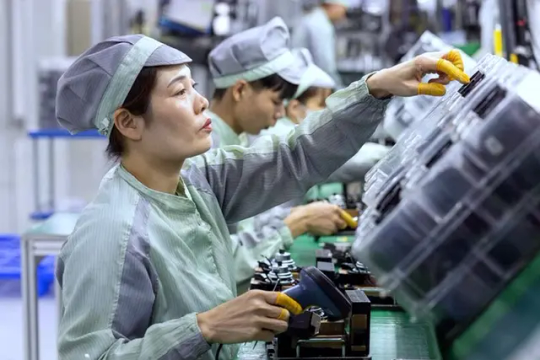
Svenimenti e turni massacranti (anche 20 senza riposo) alla fabbrica degli iPhone. Sotto accusa lo stabilimento della Foxconn a Zhengzhou. Operai della Foxconn che svengono esausti per i turni massacranti a cui sono sottoposti per sfornare i nuovi modelli dell'iPhone. È la denuncia affiorata attraverso alcuni video pubblicati nelle scorse settimane sui social network cinesi dai lavoratori dello stabilimento di Zhengzhou, nella provincia di Henan, e rilanciati dal sito 'China Labour Bulletin', osservatorio con base a Hong Kong che monitora le questioni legate al lavoro nella Repubblica popolare cinese. Lo scrive l'agenzia Asianews. "Chi può sopportare 20 giorni consecutivi di turni notturni senza alcun riposo?", si legge a commento di un video pubblicato su Douyin che descriveva una lavoratrice portata in ospedale dopo giorni di lavoro notturno. Tre giorni dopo, un altro video (che nel frattempo è stato rimosso) ha riferito che due lavoratori erano svenuti nell'area F dello stabilimento Foxconn. Un altro video caricato il 12 ottobre (anch'esso rimosso) riportava un altro episodio di svenimento di un lavoratore in un'officina. Il 'China Labour Bulletin' non è stato in grado di verificare se questi casi segnalati si sovrapponessero. Gli stabilimenti della Foxconn nella provincia dell'Henan - prosegue Asianews - hanno prolungato notevolmente l'orario di lavoro in seguito all'uscita degli iPhone 16 Pro e Pro Max: avrebbero continuato a funzionare il sabato e la domenica, con il risultato che i lavoratori avrebbero dovuto affrontare 20 giorni di lavoro consecutivi prima di ricevere un solo giorno di riposo. La settimana lavorativa prolungata promette una retribuzione più elevata, considerando che il salario orario medio è relativamente basso, pari a circa 25,6 yuan (3.33€).

La riduzione dei giorni di riposo rende però il lavoro più impegnativo dal punto di vista fisico. Accordi simili per l'allungamento dell'orario di lavoro sono stati segnalati anche nelle fabbriche Foxconn di Shenzhen, anche se non sono stati segnalati episodi di svenimento. Dopo la presentazione di denunce anonime, alcune linee della fabbrica Foxconn di Zhengzhou sono tornate a un sistema di giorni di riposo settimanali, probabilmente in risposta all'orario di lavoro irragionevolmente elevato e agli incidenti di svenimenti. Far lavorare un operaio per 20 giorni consecutivi contraddice la stessa legislazione sul lavoro in Cina. L'articolo 38 afferma chiaramente che i datori di lavoro devono garantire almeno un giorno di riposo alla settimana. Inoltre, anche le ore di straordinario previste dal programma della Foxconn superano notevolmente i limiti di legge. I resoconti di diversi lavoratori indicano che molti hanno lavorato oltre 300 ore nel mese di ottobre, con straordinari che sono quasi quattro volte superiori a quanto consentito dall'articolo 41 della Legge sul lavoro. Un recente rapporto del 'China Labour Bulletin' evidenziava già il problema diffuso degli orari di lavoro eccessivamente lunghi nel settore manifatturiero cinese. Questa situazione ha portato a un tragico caso di morte per eccesso di lavoro nella fabbrica di elettronica Qisda di Suzhou, Jiangsu, nel 2023. Il lavoratore migrante Xiao Xu, di 23 anni, è morto dopo aver lavorato per 13 turni notturni consecutivi. 'China Labour Bullettin' ricorda anche che, in qualità di principale acquirente dei prodotti Foxconn, anche Apple ha la responsabilità sociale di garantire che le condizioni di lavoro nelle sue fabbriche siano conformi alle leggi locali sul lavoro. Read the full article
2 notes
·
View notes
Text
youtube
^^^ Daniel Dale of CNN was almost breathless from reciting and refuting all the lies which Trump told at his Wisconsin rally a couple of days ago. Being a fact checker in the age of Trump is steady work.
Donald Trump is simply a diarrhea torrent of lies. He told 30,573 lies just during his administration. He's likely has told many more than that since leaving office in disgrace.
Washington Post counts 30,573 false or misleading claims in four years by Trump
One thing Trump didn't talk about at his lie-encrusted Wisconsin rally was his Foxconn fiasco near Racine.
Foxconn mostly abandons $10 billion Wisconsin project touted by Trump
Yet another business failure, this time with taxpayer money, by the frequently bankrupt "stable genius".
#donald trump#trump's lies#factchecking trump#daniel dale#abby phillip#wisconsin trump rally#wisconsin#racine#foxconn#trump's foxconn fiasco#milwaukee#cavalier johnson#trump calls milwaukee 'horrible'#election 2024#vote blue no matter who#Youtube
3 notes
·
View notes
Photo

A Foxconn data center in Mount Pleasant, Wisconsin. The company has for years promised to build a state of the art manufacturing facility.
2 notes
·
View notes
Text
The company's success certainly rests on its impressive client base, but Foxconn is just as indispensable to those clients. To understand how essential it is to Apple, for instance, you just need to look at how much of the iPhone is made by Foxconn - around 60%, by some estimates. The factories in China make some of the most essential parts of the device - camera modules, connectors, even the back of the phone casing.
‘iPhone maker Foxconn to switch to cars as US-China ties sour’, BBC
5 notes
·
View notes
Text
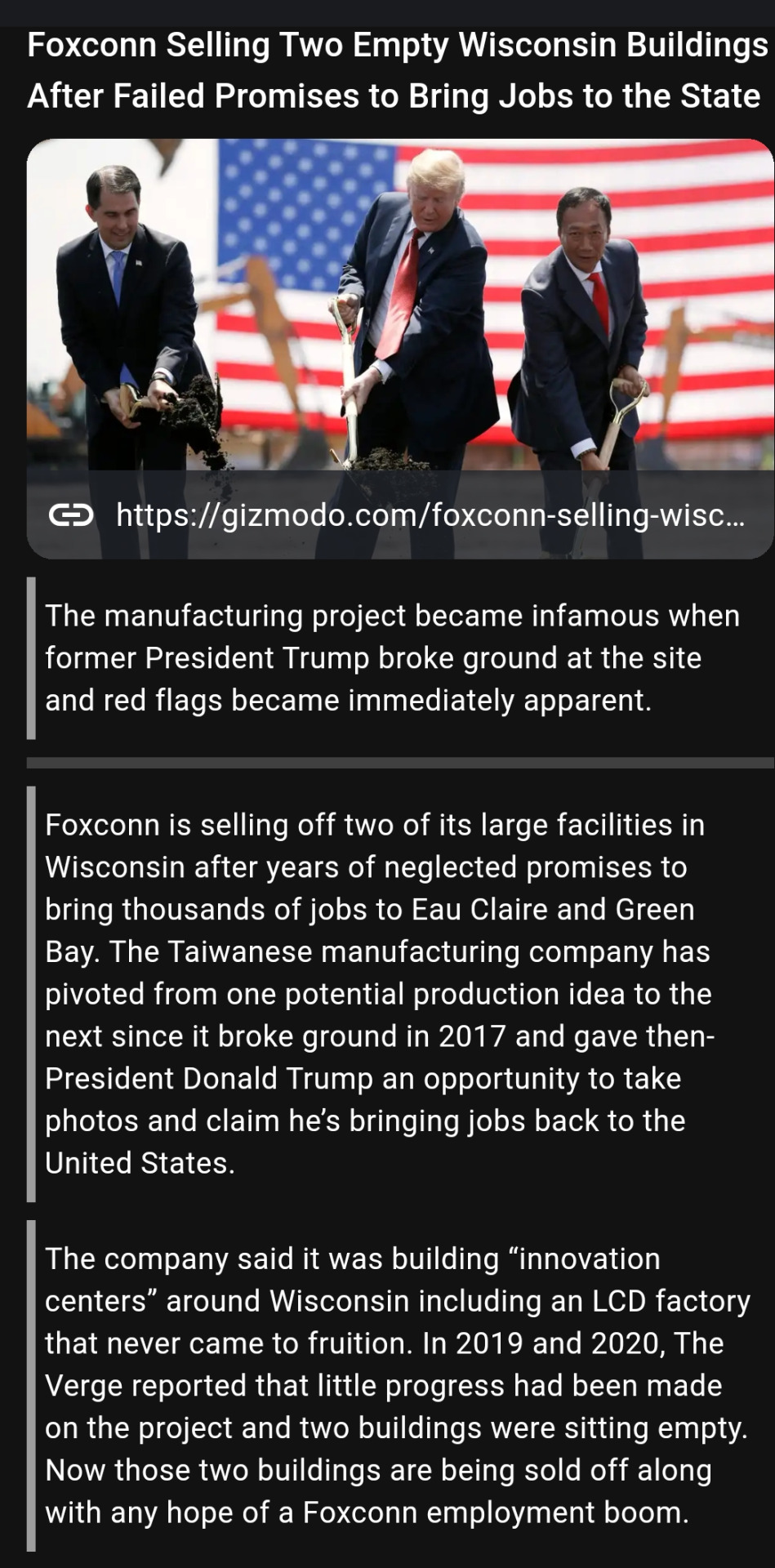
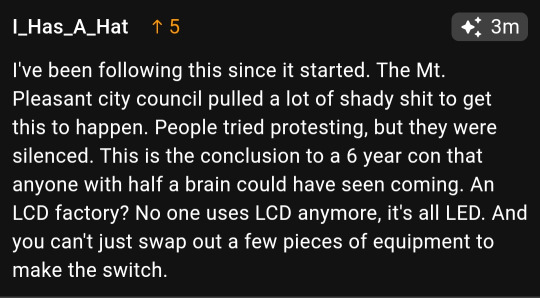
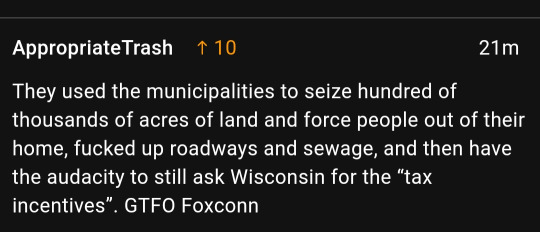
#foxconn#wisconsin#right to work#chinese company in the us#colonizers#essential communities destroyed#apple#evil#america#right wing#capitalism#usa#republicans
2 notes
·
View notes
Text
Foxconn tells a whole lot of Chinese language employees to return from its Indian iPhone factories
Apple’s largest meeting accomplice, Foxconn, has ordered greater than 300 of its Chinese language workers to return dwelling from its iPhone factories in India, Bloomberg reported, citing nameless sources. The workers instructed to return account for the majority of Foxconn’s employees in its iPhone amenities in India, and solely Taiwanese assist employees stay within the nation, the report…
0 notes
Text
Apple fueled China’s rise—but here’s how it could have been different by creating all good.
#SelfishSelflessSynergy#Apple#China#environment#ethical leadership#Foxconn#global manufacturing#Innovation#mutual benefit#paneugenesis#regeneration#supply chain
0 notes
Text
#AutomotiveInnovation#SoftwareDefinedVehicles#EVOS#AIinAutomotive#Elektrobit#Foxconn#SmartMobility#AutomotiveTech#EVDevelopment#powerelectronics#powermanagement#powersemiconductor
0 notes
Text
Nvidia y Foxconn negocian despliegue de robots humanoides en fábrica de servidores de IA en Houston
Esta sería la primera vez que un producto de Nvidia se fabricará con la ayuda de robots humanoides y sería la primera fábrica de servidores de IA de Foxconn en utilizarlos en una línea de producción. Foxconn y el fabricante estadounidense de chips de inteligencia artificial Nvidia están en conversaciones para desplegar robots humanoides en una nueva fábrica de Foxconn en Houston que producirá…
#automatización industrial#fábricas inteligentes#Foxconn#Houston#Inteligencia Artificial#Nvidia#robots humanoides
0 notes
Text
Apple’s Foldable iPhone Enters Production in Late 2025
Introduction Apple’s long-awaited Apple foldable iPhone production is inching closer to reality. According to renowned analyst Ming-Chi Kuo (MacRumors), Foxconn will begin preliminary production later this year, though several components—including its innovative hinge—are still being finalized. Production Timeline Foxconn is expected to initiate the project by late Q3 or early Q4 of 2025. Mass…
#2026 launch#4G display#5G spec#Apple#device production#foldable iPhone#Foxconn#hinge design#iPhone Fold#liquid metal hinge#Ming-Chi Kuo#Samsung Display
0 notes
Text
Exclusive: Foxconn Ships 97% of India-Made iPhones to U.S. as Apple Moves to Sidestep Trump-Era Tariffs
New Delhi, June 13 — Apple has drastically shifted its iPhone export strategy from India, with data revealing that 97% of iPhones exported by Foxconn between March and May were shipped to the United States, a sharp rise from the 2024 average of just over 50%. The move highlights Apple’s intensified efforts to bypass steep U.S. tariffs on Chinese imports.
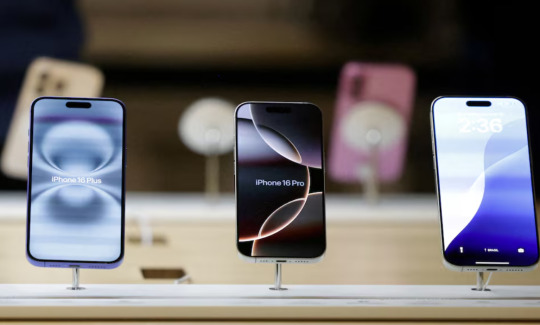
The previously unreported data, accessed by Reuters, shows that Apple is now almost exclusively using its Indian production base to serve the U.S. market. In contrast, earlier exports from India were more broadly distributed to markets like the Netherlands, Britain, and the Czech Republic.
Between March and May 2025, Foxconn exported $3.2 billion worth of iPhones from India, with May alone seeing nearly $1 billion in shipments to the U.S.—the second-highest ever, following a record $1.3 billion in March.
Apple declined to comment on the report, and Foxconn did not respond to a request for comment.
The shift comes as former U.S. President Donald Trump declared this week that Chinese products will face tariffs up to 55%, as part of a tentative agreement between U.S. and Chinese leaders. Although India remains subject to a baseline 10% U.S. import tariff, it is currently negotiating to avoid an additional 26% "reciprocal" levy proposed earlier this year.
Trump, critical of Apple’s India pivot, claimed in May: “We are not interested in you building in India. India can take care of themselves... we want you to build here,” recalling his conversation with Apple CEO Tim Cook.
Despite the political pushback, Apple’s India production is scaling up. In the first five months of 2025 alone, Foxconn shipped $4.4 billion worth of iPhones to the U.S., already surpassing its entire 2024 U.S. export volume of $3.7 billion.
To streamline operations, Apple has also chartered planes for rapid shipment of iPhone 13, 14, 16, and 16e models worth nearly $2 billion and has lobbied Indian airport authorities to cut customs clearance time at Chennai airport from 30 hours to just 6.
According to Counterpoint Research analyst Prachir Singh, “We expect made-in-India iPhones to account for 25% to 30% of global iPhone shipments in 2025, up from 18% in 2024.”
Tata Electronics, Apple’s second-largest Indian supplier, also saw a similar shift. Between March and April, 86% of Tata’s iPhone exports went to the U.S., up from just 52% in 2024. Tata began exporting iPhones only in July last year.
The development reflects India’s growing importance in Apple’s global supply chain, driven in part by Prime Minister Narendra Modi’s push to make India a smartphone manufacturing hub. However, high import duties on mobile components still make domestic production more expensive than in other countries.
Despite the shift, Apple continues to produce the majority of its iPhones in China, which historically accounts for roughly 80% of the 60 million units sold annually in the U.S.
With rising geopolitical tensions and evolving trade policies, Apple’s realignment of its export base marks a significant strategic pivot in its global operations.
#Apple#Foxconn#iPhone exports#India manufacturing#US-China tariffs#Donald Trump tariffs#Made in India#Apple India strategy#iPhone supply chain
0 notes
Text
Foxconn Set to Unveil Second Japanese Auto Partnership Amid EV Expansion Push
Taiwanese tech giant Foxconn is preparing to announce a second automotive partnership in Japan as it accelerates efforts to grow its footprint in the electric vehicle (EV) market, according to Chairman Young Liu.
“There are two Japanese automakers; one has already been announced, and the other is almost ready to be,” Liu said during Foxconn’s annual shareholders meeting on Thursday, without revealing further details.
The company recently made headlines through its EV-focused subsidiary, Foxtron Vehicle Technologies, which signed a memorandum of understanding with Mitsubishi Motors earlier this month to supply an electric vehicle model.

Foxconn, best known globally as Apple’s primary iPhone assembler, is actively diversifying its business beyond consumer electronics. The company sees Japan as a strategic market for expanding its EV operations, especially as Japanese automakers navigate increasing pressure from Chinese EV competitors in global markets like Europe, Thailand, and Brazil.
“Japan is a key focus for our EV growth,” said Jun Seki, Foxconn’s chief strategy officer for electric vehicles, at a recent Tokyo seminar. He emphasized the importance of building strong alliances with Japanese firms as they adapt to a rapidly evolving auto industry landscape.
Mitsubishi, Foxconn’s current EV partner, is part of the Renault-Nissan-Mitsubishi Alliance — a long-standing collaboration among global automakers. Foxconn has also expressed interest in a potential investment in Nissan, as it continues to explore deeper cooperation in the EV space.
In Taiwan, Foxconn's EV joint venture with Yulon Motor, known as Foxtron, primarily serves the Yulon-owned brand Luxgen. However, the company’s ambitions are clearly international, with Japan now playing a pivotal role in its global EV strategy.
Foxconn’s forthcoming announcement is expected to underscore its long-term vision of becoming a major player in the electric mobility sector, leveraging its manufacturing expertise and global partnerships.
0 notes
Text
0 notes
Text
Nvidia CEO Jensen Huang calls US ban on H20 AI chip ‘deeply painful’
[ASIA] Nvidia CEO Jensen Huang said Washington’s plan to stymie China’s artificial intelligence (AI) capabilities by restricting access to its H20 graphics processing units (GPUs) was “deeply uninformed”, as the US semiconductor giant continues to navigate through a deepening tech rivalry between the world’s two largest economies. In an interview with tech site Stratechery following his keynote…
#AI#AI Diffusion Rule#America#American#Ban#Beijing#Ben Thompson#Biden administration#Blackwell AI graphics processors#calls#CEO#China#Chinese#chip#Computex#CUDA application programming interface#deeply#DeepSeek#Donald Trump#Foxconn#GPUs#H20#Hon Hai Precision Industry#Huang#Huawei Technologies#Jensen#Jensen Huang#mainland China#Nvidia#painful
0 notes